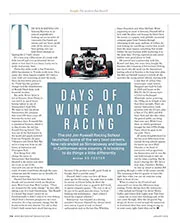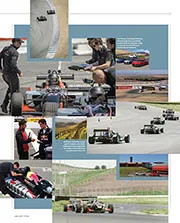

Days of wine and racing
The old Jim Russell Racing School launched some of the very best careers. Now rebranded as Simraceway and based in Californian wine country, it is looking to do things a little…
THE “NINETY” SPEED MODEL TALBOT A DISTINCTIVE CAR WITH A GENUINE SPORTS PERFORMANCE
IT would be hard to recall any sports car, which in its first season has achieved such a remarkable series of successes as the new Talbot. The reliability of this team in the classic events, together with the feat of annexing the first three places in their class on several occasions has forcibly brought this model to the notice of people who wish to go fast on occasion, but who do not wish to be continually working on their engines to maintain proper tune.
The car tested by MOTOR SPORT was a perfectly standard ” Ninety ” chassis with the regulation 4-seater body as fitted to the team cars. The racing Talbots are, of course, standard in all their components, as this point is insisted upon by the regulations for the events in which they have been running, though they have naturally been fitted and tuned with special care, and their performance is higher than the car we tried, which had only a few hundred miles to its credit and was . still slightly stiff for prolonged high speed. The first thing one notices about the Talbot is the fact that in general layout and design it is a very normal motor car, without any startling or original features to account for its
fine performance. The engine is a very neat-looking six-cylinder job, with over head valves. in the detachable head, operated by push rods, all the gear being completely en closed. The bore and stroke of 69.5 mm. and 100 mm. respectively gives a capacity of 2,276 c.c. only, and it is this fact
that makes its speed capabilities even more surprising. Everyone who watched the big racing events of this year was struck by the silence of the Talbots, and it was this feature which we first noticed when driving the Ninety.” The:very silent exhaust gives one an oppor
Ct
tunity to appreciate the mechanical silence of the rest of the chassis, and normal conversation with one’s passenger is possible at all speeds.
The heavy seven-bearing crankshaft undoubtedly goes far to account for the delightful smoothness of the engine, which has no vibration period within in its speed range, and which has more the characteristics of an electric motor than of an internal combustion engine.
It is, of course, comparatively easy to get smoothness at the expense of performance, but there is nothing woolly” about this engine, and the first few hundred yards of open road saw the car well past the ” seventy ” mark without the slightest effort, and still accelerating hard. Although the engine was new, as we have mentioned already, we found that the maximum speed, without particularly favourable conditions, was 85 m.p.h. at which speed control was light and accurate and the car held the road like a leech. 40 m.p.h. on second and 60 m.p.h. on third were suitable speeds for changing up to the next gear, giving approximately 4000 r.p.m. of the engine in each
case. The revs.
can le pushed round easily to 4500 r.p.m, or more, but out of respect for the new engine we refrained from indulging to any extent on these lines. The actual gear change is very light and easy, being right-hand operated, and the lever works visible in a gate. Another factor which contributes greatly to the ease of gear changing is the very light and smooth single plate clutch, running dry and lined with Ferodo. The clutch is automatically lubricated from the engine, as is also the gear box, thus reducing the number of things
to be remembered, and making it more than ever a car requiring scant attention.
For the benefit of those who dislike grovelling on the earth to drain the sump, and who therefore leave undone this highly necessary operation for many months after it is due, the dip-stick is also arranged as a drain tap. To operate it, it is only necessary to open the bonnet and press the nob, while to prevent unauthorised or accidental use of this, a neat safety catch is provided. Radiator connections cause extra work when dismantling (even if one uses Mr. Robinson’s excellent Jubilee hoseclips), and on the Talbot the lower water connection has been abolished by mounting the radiator
direct on the crankcase. This has also the more important effect of preventing relative movement of engine and radiator on bad roads, and so avoids strain on the radiator itself.
A criticism which we have heard from various people about the Talbot is that it is too high. It certainly looks high in comparison with many present day sports cars, but having driven it, and examined it, we feel convinced that this is merely because the makers have not attempted to make it look lower than it is. This can be, and often is done, by cutting down the radiator height and adding ” scenery ” below the chassis level. This, however, does not alter the one thing that matters, the centre of gravity, and from our experience of handling the Talbot we can definitely say that this is not too high. It is quite free from any sign of rolling on corners,
and the steering enables considerable liberties to be taken with the car on a winding road. It is light without being low-geared and this gives it that essential quality of liveliness which enables the driver to feel exactly what is happening on a corner and to place the car exactly where he wants it. The brakes are in keeping with the rest of the car, and are in actual fact, very nearly the most powerful of any we Continued on page 15
have tried. On a dry, concrete road, we brought the car to rest from 40 m.p.h. in 43 ft., and when the surface was examined it was found that the near side rear wheel had just locked in the last 6 feet while there was no other sign of locking at all. This means that in any normal circumstances of stopping there is little or no possibility of locking the wheels, while the braking power is very much above the average. This model, as may be gathered from its name, is intended to be capable of 90 m.p.h., and when a new engine does 85 m.p.h. at the first time of asking, it shows that there is not likely to be much difficulty in
reaching the maker’s claim.
Some people consider a car’s performance in relation to its engine size, and some in relation to its price, but as the Talbot engine is only 2f litres, and unsupercharged, while it costs only £495 for the short chassis, this car must take a very high place by whatever standards it is judged.
Taken all round it is one of the pleasantest and safest sports cars we have tried, and our thanks are due to Messrs. Fox and Nicholls, who have entered the Talbot team in all the big races of this year, for giving us the opportunity of driving such an excellent vehicle.



